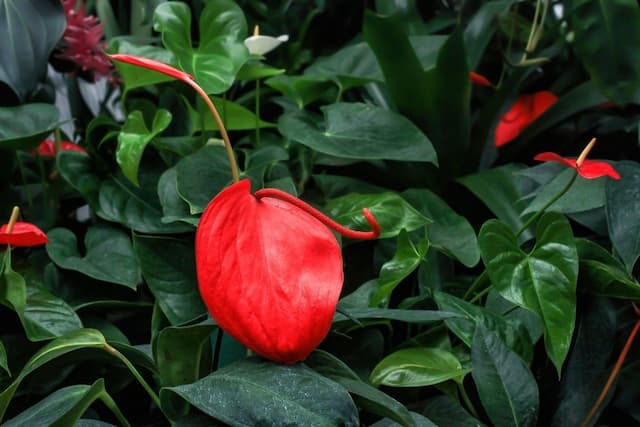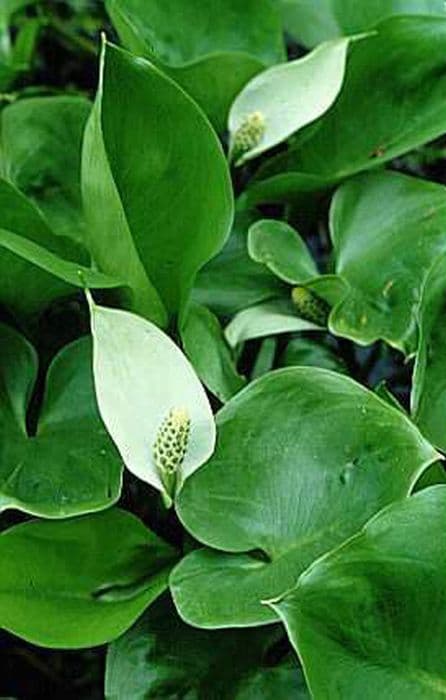Calla Lily 'Butter Queen' Zantedeschia 'Butter Queen'

ABOUT
The 'Butter Queen' is a captivating plant commonly known as the calla lily. Boasting a brilliant yellow hue, this variety is renowned for its unique, showy spathes — the flamboyant, funnel-shaped structures resembling flowers, which gracefully enfold the actual tiny flowers located on the central, finger-like spadix. The spathes have a luscious creamy to buttery yellow tone that exudes a sense of warmth and sophistication. The plant has a lush and elegant appearance, with striking, glossy green leaves that are often arrow-shaped or spear-like in form. These leaves sometimes possess white or lighter colored spots, adding to the visual interest of the plant. These spotted leaves frame the radiant spathes, creating a dramatic contrast that enhances the allure of the 'Butter Queen.' The calla lily's beauty is not just in its blooms but also in the elegant, smooth lines of its overall form, which lends itself to being a favored choice for floral arrangements and as an ornamental plant in gardens. With its sophisticated blooms and attractive foliage, the 'Butter Queen' calla lily is a stunning addition that brings a touch of class and vivid color wherever it is grown.
About this plant
 Names
NamesFamily
Araceae
Synonyms
Calla Lily, Arum Lily
Common names
Zantedeschia 'Butter Queen'
 Toxicity
ToxicityTo humans
Calla Lily, which is the most common name for Zantedeschia 'Butter Queen', is toxic to humans. The plant contains calcium oxalate crystals which, when ingested, can lead to symptoms such as burning and swelling of lips, mouth, tongue, and throat. Other possible symptoms are difficulty swallowing, nausea, and vomiting. In severe cases, breathing difficulties may occur due to swelling of the throat.
To pets
Calla Lily is also toxic to pets, such as cats and dogs. Similar to its effects on humans, the calcium oxalate crystals found in the plant can cause oral irritation, intense burning and irritation of mouth, tongue and lips, excessive drooling, vomiting, and difficulty swallowing when ingested by pets. Depending on the amount ingested, symptoms can range from mild to severe, and it is important to seek veterinary care if you suspect your pet has consumed any part of the plant.
 Characteristics
CharacteristicsLife cycle
Perennials
Foliage type
Deciduous
Color of leaves
Green
Flower color
Yellow
Height
1-2 feet (30-60 cm)
Spread
1-2 feet (30-60 cm)
Plant type
Herb
Hardiness zones
8
Native area
South Africa
Benefits
 General Benefits
General Benefits- Easy to Grow: Zantedeschia 'Butter Queen', commonly known as Calla Lily, is relatively easy to cultivate in various garden settings, making it suitable for gardeners of different experience levels.
- Attractive Flowers: The plant is prized for its beautiful trumpet-shaped flowers, which can add visual interest and elegance to gardens and indoor settings.
- Versatile: Calla Lilies can be grown in beds, borders, containers, and water gardens, offering flexibility in landscape design.
- Long Blooming Period: With a long flowering season from late spring to mid-summer, they provide a lasting display of color.
- Range of Uses: They are popular for use in bouquets, floral arrangements, and as cut flowers due to their striking blooms and long vase life.
- Attracts Wildlife: The blooms can attract beneficial insects to the garden, such as bees and butterflies, which are important pollinators.
 Medical Properties
Medical PropertiesThis plant is not used for medical purposes.
 Air-purifying Qualities
Air-purifying QualitiesThis plant is not specifically known for air purifying qualities.
 Other Uses
Other Uses- Photography Prop: The Calla Lily, with its stunning Butter Queen colors, is often used by photographers as a prop in portraits and still life photography due to its elegant appearance.
- Art and Inspiration: Artists may use the Butter Queen variety of the Calla Lily as a subject for painting or sketching due to its unique color and form.
- Educational Tool: Horticulture students may study the Butter Queen Calla Lily as an example of hybridization and plant breeding techniques.
- Culinary Garnish: Though not commonly known for edible parts, the flowers can sometimes be used as an extravagant garnish for special dishes in high-end culinary presentations.
- Event Themes: Calla Lilies, including the Butter Queen variety, can inspire event themes, with their elegance and color schemes influencing decor and attire for occasions like weddings and galas.
- Fashion Influence: The shape and color of the Calla Lily Butter Queen can influence fashion designs, often seen in floral patterns or the draping of fabrics.
- Craft Material: Dried Calla Lily blooms, such as those of the Butter Queen variety, can be used in craft projects, like creating bookmarks or pressed flower arrangements.
- Color Palette Schemes: The Butter Queen's unique color can be used as inspiration for interior design and color palette schemes in homes and commercial spaces.
- Jewelry Making: The elegant form of the Calla Lily can inspire jewelry pieces, where the Butter Queen's shape is replicated in metal or other materials.
- Symbolism in Literature: Calla Lilies, including the Butter Queen, can serve as symbols in literature and poetry, often representing purity, beauty, or resurrection.
Interesting Facts
 Feng Shui
Feng ShuiThe Calla Lily is not used in Feng Shui practice.
 Zodiac Sign Compitability
Zodiac Sign CompitabilityThe Calla Lily is not used in astrology practice.
 Plant Symbolism
Plant Symbolism- Beauty: Calla lilies are commonly associated with beauty due to their elegant and graceful shape.
- Elegance: The sleek lines and smooth contours of the flower embody sophistication and refined taste.
- Purity: The clean, bright appearance of calla lilies is often linked to the idea of purity and innocence.
- Faith: In some cultures, their trumpet-like shape symbolizes triumph and is connected to religious faith or spiritual enlightenment.
- Rebirth: Calla lilies bloom in the spring and are seen as symbols of new beginnings and rebirth.
- Overcoming challenges: Their ability to grow in marshy, challenging conditions can represent overcoming difficulties or adversity in life.
 Water
WaterThe Calla lily, commonly referred to as Zantedeschia 'Butter Queen', should be watered thoroughly once the top inch of soil feels dry to the touch which generally means watering once a week. It's important to provide enough water to soak the soil all the way to the roots without waterlogging the plant. During active growing seasons, typically in spring and summer, the Calla lily may require more frequent watering, possibly up to twice a week. Ensure the plant receives approximately one gallon of water each time, adjusted for the pot size and the plant's environment. During dormancy in fall and winter, reduce watering frequency.
 Light
LightThe Calla lily thrives best in bright, indirect sunlight. Place it in a location where it can receive plenty of light without being exposed to harsh midday sun, which can scorch its leaves. A spot near an east-facing or west-facing window is typically ideal for this plant to flourish.
 Temperature
TemperatureThe Calla lily prefers temperatures between 65 and 75 degrees Fahrenheit. It can survive minimum temperatures of about 50 degrees Fahrenheit but should not be subjected to temperatures below 45 degrees Fahrenheit as it may damage the plant. The ideal condition for the Calla lily is to maintain a consistent temperature within this range without drastic fluctuations.
 Pruning
PruningPrune the Calla lily by removing spent blooms and yellowing leaves to encourage healthier growth and more blooms. The best time for pruning is after flowering, typically in the fall. This plant does not require extensive pruning; occasional tidying up to remove dead or damaged tissue is often enough.
 Cleaning
CleaningAs needed
 Soil
SoilThe Calla Lily 'Butter Queen' thrives in a soil mix that is well-draining, rich in organic matter, and slightly acidic to neutral, with a pH ranging from 6.0 to 7.0. A mixture of two parts peat moss or coco coir, one part perlite or sand, and one part loamy garden soil works well for potting.
 Repotting
RepottingCalla Lilies, including 'Butter Queen', should generally be repotted every two years to refresh the soil and accommodate root growth. However, watch for signs like roots circling the pot or emerging from drainage holes as indicators of when to repot.
 Humidity & Misting
Humidity & MistingCalla Lily 'Butter Queen' prefers high humidity levels, above 60%, but can tolerate a range down to about 40%. Maintain the ideal humidity by using a humidifier, placing a water tray near the plant, or grouping plants together.
 Suitable locations
Suitable locationsIndoor
Place Calla Lily in bright, indirect light; keep soil moist.
Outdoor
Plant in partial shade, protect from strong winds, keep soil moist.
Hardiness zone
8-10 USDA
 Life cycle
Life cycleThe Zantedeschia 'Butter Queen', commonly known as the Calla Lily 'Butter Queen', begins its life cycle when a rhizome is planted in fertile, well-drained soil, preferably in spring. After planting, the rhizome sprouts into a foliage of broad leaves and eventually develops the signature funnel-shaped cream-colored spathes with a central yellow spadix, which is the inflorescence. The plant blooms primarily in the late spring to summer. Once flowering is complete, the plant will go dormant in the fall, with the foliage yellowing and dying back. During dormancy, the plant conserves energy in the rhizome, which can be divided and replanted to propagate new plants. With the return of warmer temperatures, the cycle begins anew with the rhizome sprouting once again in the spring.
 Propogation
PropogationPropogation time
Spring to Summer
The Calla Lily 'Butter Queen' can be propagated through division, the most popular method, which is best carried out in late winter or early spring just before the growing season begins. To propagate by division, carefully lift the entire plant from the ground or pot, shaking off excess soil to reveal the rhizomes. Using a sharp knife, divide the rhizomes ensuring each section has at least one growth point or eye. Allow the cut sections to dry for a few hours to form a callus over the wounds, which helps prevent rotting when planted. Then, plant the divided rhizomes about 3 to 4 inches deep (7.5 to 10 cm) in well-draining soil, spacing them approximately 12 inches (30 cm) apart to allow for growth. Water the newly planted rhizomes lightly to settle the soil and keep the soil moist but not waterlogged as the new plants establish.









